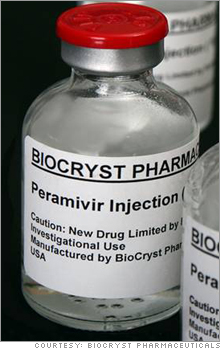Drugs and fear: A new bird flu flurryNew strain discovery prompts concern among researchers, may spur languishing biotech treatment investment.NEW YORK (CNNMoney.com) -- Scientists have discovered a new strain of bird flu that has infected humans in China, which could arouse fresh fears of a possible pandemic and spur further interest in experimental drugs and vaccines. Dr. Robert Webster of St. Jude's Children's Research Hospital in Memphis, along with other scientists from the U.S. and China, announced "the emergence and pre-dominance of a previously uncharacterized" substrain of bird flu, appearing in Chinese poultry since late 2005.
The scientists, who published their findings on the Proceedings of the National Academy of Sciences Web site, also reported that the substrain of H5N1, also known as bird flu, had "caused recent human infection in China." Researchers noted that some of these cases were residents of urban areas remote from poultry farms. "The development of highly pathogenic avian H5N1 influenza viruses in poultry in Eurasia accompanied with the increase in human infection in 2006 suggests that the virus has not been effectively contained and that the pandemic threat persists," the researchers concluded. Bird flu typically emerges in poultry and wild birds, but the often fatal virus can be spread to humans who are in close contact with the infected birds. The virus emerged in Asia in 2003, and to date it has infected 256 humans and killed 151, with Vietnam and Indonesia accounting for the majority of cases, according to the World Health Organization. But there have been only limited incidents of human-to-human transmission, with nothing sustainable. Human-to-human transmission is the greatest fear of health workers around the world because strong cases of human-to-human transmission have the potential to spark a global pandemic, like the strain of influenza that killed tens of millions in 1918. The U.S. Department of Health and Human Services (HHS) has estimated that a pandemic outbreak in the U.S. could kill up to 300,000 people. And with more than 50 known strains of H5N1, the discovery of a new one doesn't necessarily mean the end is nigh, experts point out. "I don't consider it that worrisome yet," said Ren Benjamin, biotech analyst for Rodman & Renshaw. "Once it mutates or becomes more pathogenic, then it becomes something to worry about. If you make the discovery that there's human-to-human [transmission,] then the red flag will go up." Boon for biotechs? Congress has approved $3.3 billion in funding for antiviral drugs and vaccines to fight avian flu, less than half the $7.1 billion requested by President Bush. As part of this, HHS has allocated at least $300 million to fund development of antivirals to decrease dependency on vaccines. Also, the agency has awarded $1 billion to drugmakers to develop a better method of making a vaccine. BioCryst Pharmaceutical (down $0.12 to $11.30, Charts), an Alabama-based biotech, stands to benefit from increased interest in its experimental anti-viral Peramivir, particularly since its stock price has fallen by nearly a third in the year to date. "The fact that the [BioCryst] stock has been so depressed suggests that avian flu has been mitigated, but that's not the case," said Vinny Jindal, biotech analyst for ThinkEquity. "It appears to be expanding geographically and becoming more pathogenic." Peramivir is an experimental antiviral drug, not a vaccine, which means it would be injected as a treatment after the patient is infected. Vaccines are injected prior to infection, with the intention of fighting the virus before it takes effect. But will Peramivir be effective against the newly discovered strain of H5N1? "We have actually evaluated Peramivir against 53 H5N1 strains already, and Peramivir is potent against all those strains," said Dr. Shane Arnold, director of Peramivir research for BioCryst. "We believe that Peramivir will be effective [against the new strain,] but until we do the study we can't know for sure." Roche Holding (Charts), the Swiss drug company that produces the antiviral Tamiflu, could also benefit from increased interest in H5N1. Tamiflu is the only bird flu treatment currently on the market, though some analysts believe that Peramivir has better potential in fighting the disease. Sanofi-Aventis (down $0.33 to $42.10, Charts), the French drugmaker, is considered a lead company in developing a bird flu vaccine. But even if a successful vaccine is developed, there is a concern in the health community that it wouldn't be distributed to the population in time to ward off mass infection in the event of a pandemic. Other companies working on potential bird flu treatments include Generex Biotechnology (up $0.13 to $2.15, Charts), Novavax (down $0.05 to $4.25, Charts) and Avi Biopharma (Charts). "Anytime that a new strain or a new variant is discovered or highlighted in the media, that's good news for any company working in the anti-viral space for avian flu, or even the vaccine space, because it shows the potential for a pandemic is real," said Benjamin of Rodman & Renshaw. The analysts interviewed for this story do not own shares of stock in companies mentioned here. |
|

